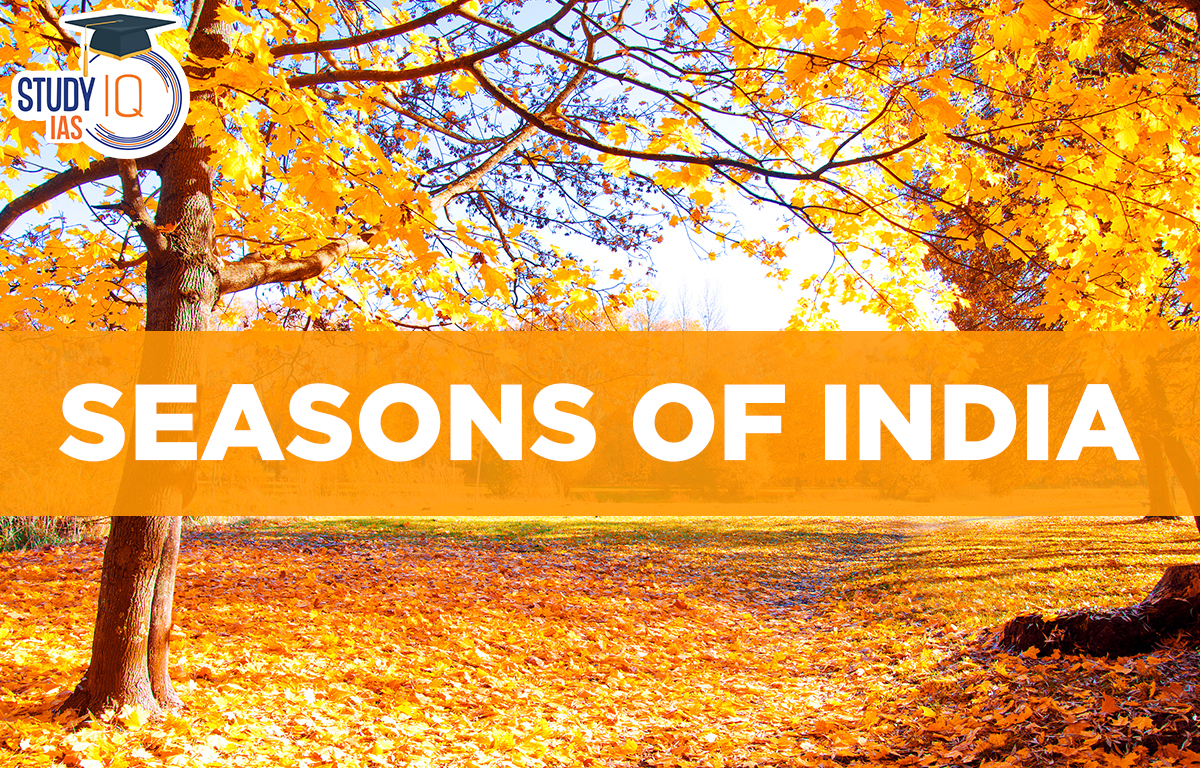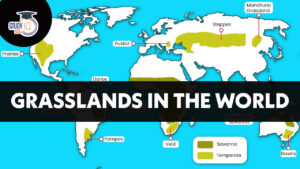Table of Contents
India, with its diverse geography, experiences a range of climates and distinct seasons. The country’s climate is primarily influenced by the tropical monsoon, with five major seasons—Winter, Summer, Monsoon, Spring, and Autumn—each contributing to the agricultural and socio-economic patterns. Understanding of types of Seasons in India is essential for UPSC aspirants, as they impact India’s economy, culture, and natural environment.
Seasons in India
India, being large in geography as well as varied in climate, has different seasonal changes. Although the traditional Hindu calendar has six seasons (referred to as Ritus), the India Meteorological Department (IMD) officially only identifies four broad seasons.
Although IMD’s four-seasonal classification is utilised for climatic purposes, the classical six-seasonal conception tends to find practice and concordance with cultural traditions and farming cycles of different regions of India. The nation’s variegated topography, such as the Himalayas towards the north and the Thar Desert towards the west, also affects local climatic differences within these broad ranges of seasons.
| System | Seasons in India | Season Months |
|---|---|---|
| IMD (4 seasons) | Winter, Summer, Monsoon, Post‑Monsoon | Winter: Dec–Feb; Summer: Mar–Jun; Monsoon: Jun–Sep; Post‑Monsoon: Oct–Dec |
| Traditional (6 ritus) | Vasanta, Grīṣma, Varṣā, Śarad, Hemanta, Śiśira | Mid‑Feb → Mid‑Apr → Jun → … → Mid‑Feb |
Types of Seasons in India
The Seasons of India are mainly classified as:
- Summer,
- Winter,
- Autumn,
- Spring and Monsoon seasons.
| Season Name (Traditional Hindu Calendar Name) | Months |
| Spring Season (Vasant) | February to March |
| Summer Season (Grishma) | March to May |
| Monsoon Season (Varsha) | June to September |
| Autumn Season (Sharad) | October to November |
| Pre-Winter Season (Hemant) | December to January |
| Winter Season (Shishir) | January to February |
Classification of Seasons in India
The classification of seasons in India can be viewed through two primary lenses: the modern meteorological classification and the traditional Hindu calendar. Both perspectives offer a unique understanding of the seasonal cycles that shape life in the country.
Modern Meteorological Classification
According to the India Meteorological Department (IMD), India experiences four main seasons:
1. Winter (December to February)
- Temperature: It’s cold, but temperatures vary a lot by region. In northern India, especially in the Himalayas, it can freeze and snow. In contrast, southern India stays fairly mild.
- Weather: Clear skies, low humidity, and cold winds. Snowfall in northern hill stations.
- Daylight: Short days and long nights.
- Cultural Significance: Celebrations include Christmas, New Year, Lohri, Makar Sankranti, and Pongal. Winter sports like skiing are popular in the north.
2. Summer (March to June)
- Temperature: Extremely hot, particularly in northern and central India, with temperatures often exceeding 40°C (104°F).
- Weather: Hot and dry conditions with occasional dust storms.
- Daylight: Long days and short nights.
- Cultural Significance: Festivals such as Holi, Rath Yatra, and Guru Purnima. Families often travel to cooler hill stations to escape the heat.
3. Monsoon (June to September)
- Temperature: Cooler than summer, averaging around 34°C.
- Weather: Heavy rainfall, particularly in western coastal regions and the northeast. Important for agriculture.
- Daylight: Days start to shorten.
- Cultural Significance: Festivals like Onam, Janmashtami, Raksha Bandhan, and Teej. The monsoon is crucial for replenishing water sources and sustaining agriculture.
4. Autumn (October to November)
- Temperature: Mild and pleasant, with average temperatures around 33°C.
- Weather: Clear skies, low humidity, and cool breezes.
- Daylight: Days and nights are nearly equal in length.
- Cultural Significance: Celebrations include Navratri, Durga Puja, Diwali, and Vijayadashami. It is also the harvest season for kharif crops.
Traditional Hindu Calendar Classification
The traditional Hindu calendar divides the year into six seasons, each lasting approximately two months:
1. Vasant Ritu (Spring)
- Duration: February to March (Chaitra and Baisakh in the Hindu calendar).
- Temperature: Pleasant and mild.
- Weather: Blooming flowers and green landscapes.
- Cultural Significance: Festivals like Holi, Vasant Panchami, and Baisakhi. Symbolizes renewal and new beginnings.
2. Grishma Ritu (Summer)
- Duration: April to June (Jyeshta and Aashaadha in the Hindu calendar).
- Temperature: Extremely hot and dry.
- Weather: Scorching sun and high temperatures.
- Cultural Significance: Festivals such as Guru Purnima and Rath Yatra. A time for traditional cooling drinks and foods.
3. Varsha Ritu (Monsoon)
- Duration: June to August (Shravana and Bhadrapada in the Hindu calendar).
- Temperature: Cooler with heavy rainfall.
- Weather: Monsoon rains vital for agriculture.
- Cultural Significance: Festivals like Teej, Raksha Bandhan, and Janmashtami. The season of rejuvenation and renewal.
4. Sharad Ritu (Autumn)
- Duration: August to October (Ashwin and Kartik in the Hindu calendar).
- Temperature: Mild and pleasant.
- Weather: Clear skies and low humidity.
- Cultural Significance: Festivals such as Navratri, Durga Puja, and Diwali. Marks the harvest season.
5. Hemant Ritu (Pre-Winter)
- Duration: October to December (Agrahayana and Pausha in the Hindu calendar).
- Temperature: Moderately cold.
- Weather: Transition from autumn to winter.
- Cultural Significance: Festivals like Diwali and Bhai Dooj. A time of preparation for the colder months.
6. Shishir Ritu (Winter)
- Duration: December to February (Magha and Phalguna in the Hindu calendar).
- Temperature: Cold, with regional variations.
- Weather: Clear skies and cold winds.
- Cultural Significance: Festivals such as Makar Sankranti, Lohri, and Pongal. Winter sports and traditional winter foods are prominent.
Winter Season in India
- Mid-December through mid-March is considered the Winter Season in India.
- South of the equator is where the sun appears to be travelling.
- This season is marked by clear skies, pleasant weather, cold and gentle northeast trade breezes, low temperatures, low humidity, and a wide variety of temperatures.
- Particularly during the winter months in the interior of the nation, the diurnal temperature variation is incredibly wide.
- The 20°C isotherms and the Tropic of Cancer are nearly parallel. To the south of this isotherm, temperatures are higher than 20 °C.
- There is no distinct winter climate in this area. In some areas of Tamil Nadu and Kerala, the temperature frequently reaches 30 degrees.
- The north has distinct winter weather with an average temperature below 21°C.
- The Gangetic plains have a mean minimum temperature of about 10°C, compared to a mean minimum of about 5°C in north-western India.
- India’s coldest place is the Dras Valley in Kashmir. The lowest temperature ever at Dras was -45°C in 1908.
Summer Season in India
- Mid-March to May is considered the Summer Season in India.
- This season is characterised mostly by high temperatures and little humidity.
- The pre-monsoon season is another name for the hot weather season.
- There is a wide range of sun insolation because the sun appears to wander between the equator and the Tropic of Cancer.
- The southern regions of the nation are considerably warmer in March and April, while June brings greater temperatures to northern India.
- The country’s southern regions record the highest temperatures in March (40–45°C).
- The highest temperature ever recorded in Madhya Pradesh’s northern regions was around 45°C in April.
- The hottest month is May, when Rajasthan has had temperatures as high as 48°C.
- June is when temperatures are at their maximum in Punjab and Haryana.
- The two highest recorded temperatures were 50.6°C on June 14, 1935, at Ganganagar, and 50.5°C on May 10, 1956, in Alwar.
- Just before the onset of the southwest monsoon, the highest temperatures are recorded (late May).
- The temperature range throughout the day is likewise extremely wide.
- The mercury may rise as high as 18°C in some places.
- Maximum summer temperatures are noticeably lower in the coastal and southern peninsular regions due to the cooling impact of the sea.
- Temperatures on the West Coast are typically cooler than those on the East Coast due to the predominance of westerly winds.
- The temperatures at sea and on land are very different.
- In this season, heat waves struck the northern and central areas of India.
- Rajasthan, Punjab, and Haryana experience most of the heat waves (locations far away from the sea).
- From here, they expanded over Bihar and Uttar Pradesh.
- Heat waves in Odisha and Andhra Pradesh are brought on by strong northwesterly winds that are hindered from moving down the eastern coastal belt due to a high divergence in northwestern India and a lengthy land journey over hot regions.
- Heat Waves start to appear towards the end of April, and their frequency peaks in May.
- They continue till the arrival of the southwest monsoon.
- In most cases, heat waves last four to five days.
- On the peninsula south of 13°N latitude, however, heat waves are rare because of the coastal climate that predominates there.
Monsoon Season in India
- June to September is considered the Rainy Season or Monsoon in India.
- The significant increase in temperature across the northwest plains in May has intensified the low-pressure conditions there.
- By early June, they are strong enough to draw trade winds from the Indian Ocean that are native to the Southern Hemisphere.
- These trade winds from the southeast pass via the Arabian Sea and the Bay of Bengal after crossing the equator, only to be caught up in the airflow over India.
- As they cross the heated equatorial currents, they carry a lot of moisture with them.
- After crossing the equator, they proceed southwestward.
- As a result, the southwest monsoon is named.
Southwest Monsoon Season
- The southwest monsoon season has a sudden onset of rain.
- The initial downpour has the impact of sharply decreasing the temperature. When the monsoons “break” or “burst,” winds carrying moisture accompanied by ferocious thunder and lightning occur.
- The monsoon may begin in the first week of June in the coastal regions of Kerala, Karnataka, Goa, and Maharashtra, while it may begin in the first week of July in the interior.
- The daily temperature drops from mid-June to mid-July by 5°C to 8°C.
- The southwesterly direction of these winds as they reach the land is modified by the relief and thermal low pressure over northwest India.
- As the mainland approaches, the monsoon splits into two branches:
- The Arabian Sea branch
- The Bay of Bengal branch
Retreating Monsoon Season or Cool Season
In October and November, monsoons are known to retreat, hence called the Retreating Monsoons. The Ganga Plains low-pressure trough starts to travel southward towards the end of September in reaction to the sun’s southerly march, which weakens the southwest monsoon. Western Rajasthan is free of the monsoon by the first week of September. It will have left Rajasthan, Gujarat, the Western Ganga Plain, and the Central Highlands by the end of the month.
Retreating Monsoon in the Southern Half of India
By early October, the low-pressure system had moved across the northern portions of the Bay of Bengal, and by early November, it was over Karnataka and Tamil Nadu. By the middle of December, the area of low pressure will be entirely gone from the Peninsula. The southwest monsoon season is ending as the weather becomes clearer and warmer. The soil is still drenched. The high warmth and humidity make the weather uncomfortable. The term “October heat” is used to describe this.
Retreating Monsoon in the Northern Half of India
In the second half of October, temperatures start to rapidly fall, particularly in northern India. While the eastern section of the Peninsula has rained during the retreating monsoon, the weather in north India remains dry. In this region, October and November are the wettest months of the year. Cyclonic depressions that develop over the Andaman Sea and travel to the eastern coast of the southern Peninsula are associated with the arrival of the rainy season.
Retreating Monsoons Effects
Tropical cyclones are a major threat, especially to the crowded deltas of the Godavari, Krishna, and Kaveri rivers, where they cause destruction each year. They also affect the coasts of West Bengal, Bangladesh, and Myanmar. Most of the rainfall on the Coromandel Coast comes from these storms. However, such cyclones are less common in the Arabian Sea.
Significance of Understanding Seasons in India
- Agricultural Dependency: Approximately 60% of India’s population relies on agriculture, and with much of the country’s agriculture being rain-fed, seasonal understanding is crucial for crop planning and food security.
- Disaster Preparedness: India faces natural calamities like floods and droughts, especially during the monsoon season, impacting lives and the economy.
- Economic Planning: The seasonal cycle affects the Gross Domestic Product (GDP), employment, and income, especially in agriculture, tourism, and other season-dependent sectors.
- Cultural Relevance: Festivals and cultural practices across India are deeply connected with the seasonal cycle, reflecting the seasonal dependence of traditional Indian life.
India’s distinct seasons play a crucial role in shaping the country’s agricultural, cultural, and economic life. The cycle of winter, summer, monsoon, spring, and autumn brings with it a diverse range of experiences and challenges, from extreme temperatures in summer to the refreshing rains of the monsoon. Each season holds a special place in Indian culture, with festivals and traditions deeply rooted in the changing weather patterns. Understanding these seasonal variations is essential to appreciate the rhythm of life in this vibrant country.


 Critical Minerals, Key Issues, Importanc...
Critical Minerals, Key Issues, Importanc...
 Grasslands in the World, Map, Types and ...
Grasslands in the World, Map, Types and ...
 Places in News for UPSC 2025 for Prelims...
Places in News for UPSC 2025 for Prelims...





















